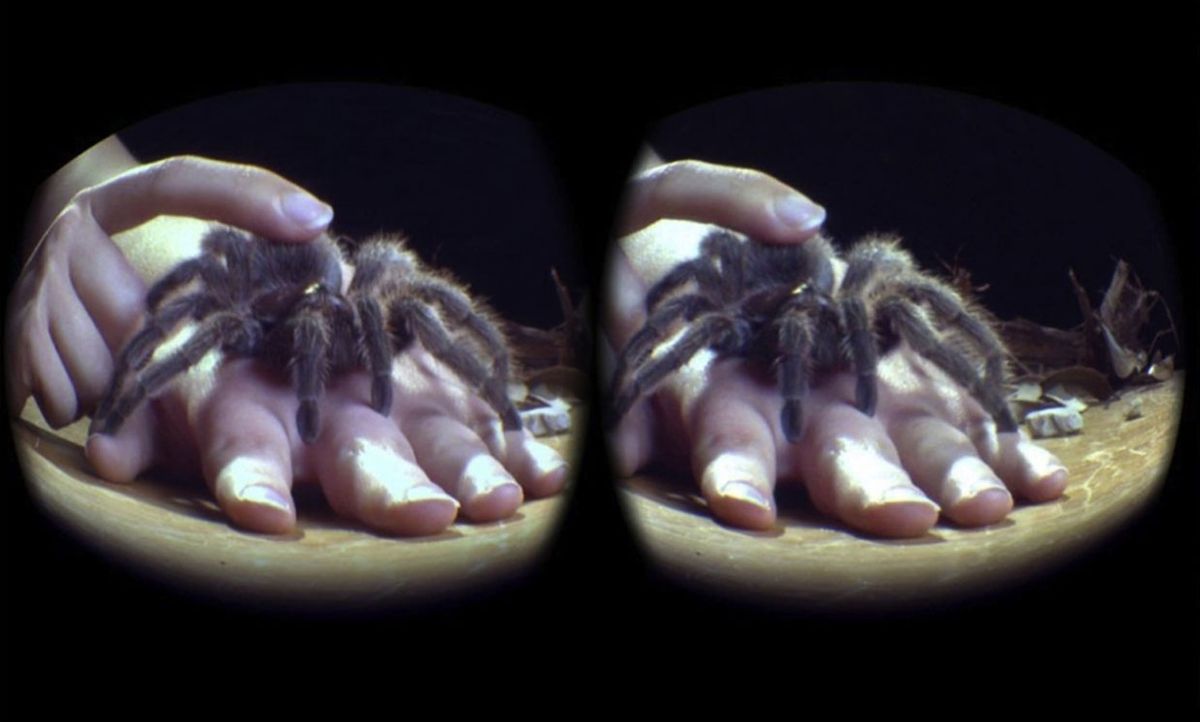A woman with a fear of spiders sits in a chair wearing a virtual reality headset. She watches 3D video footage of a tarantula walking over what seems like her hand. Then the spider creeps toward her face. She watches the 5-minute video six times.
It sounds like torture, but the video is supposed to help. The idea is to repeatedly, but safely, expose a person to the thing she fears until she no longer fears it. Doctors have long used the treatment, called exposure therapy, to help alleviate their patients’ phobias.
Traditionally, therapists deliver the treatment live. They’ll present spiders to people with arachnophobia, and blood to people with hemophobia. But live exposure therapy is harder to deliver to people who fear things that can’t be brought into an office building, like airplanes (aerophobia) or large animals (zoophobia).
So in recent years, researchers have used computer generated imagery (CGI) and virtual reality (VR) to deliver exposure therapy to people with phobias. The patient faces her fears in the safety of a virtual world.
It seems to work. “There is evidence that computer generated virtual reality is as effective or almost as effective as [live] treatment for anxiety disorders,” says Emily Carl, a Ph.D. student at the University of Texas at Austin, who is studying the therapy. “But you run the risk of it not being quite real and that being distracting,” she says, referring to the “uncanny valley” effect of CGI. “Say you have a room full of [computer generated] people listening to you for social anxiety. If they’re not quite humanlike, but they’re close, you might end up focusing on that, and that weirding you out in a way that’s not necessarily helpful for treatment.”
Carl is part of a group of researchers at University of Texas at Austin who say 3D video footage of real stimuli, delivered through a VR headset, may treat phobias as well as, or better than, CGI. To test this hypothesis, the researchers created a 3D spider-viewing experience and tested it on 77 college students who have a fear of spiders.
The results: After being immersed in the 3D video, the students were braver when faced with a real spider. And it was a big one: a Chilean rose hair tarantula. The researchers published their findings this month in the Journal of Anxiety Disorders. The study was conceived and led by Sean Minns, now a graduate student at Teachers College, Columbia University.
In the 3D video, the tarantula crawls over a hand and creeps closer and closer to the viewer. It’s like a scene from the 1990 horror flick Arachnophobia, only therapeutic, because nothing bad happens.
“You could see how physically uncomfortable the participants were,” says Minns. “As the spider got closer, people would recoil.” That’s a good thing, because it means the immersive experience of it being 3D made it feel real, he says.
The team made the videos using a stereoscopic 3D dual-camera rig, in which two cameras, positioned to mimic the natural distance between the eyes, shoot footage simultaneously. The footage from the cameras are projected onto the left and right lenses of an unmodified Oculus Rift DK1 VR headset, creating a sense of depth to the viewer.
To find out if the treatment worked, the researchers used a live tarantula to test the participants’ fear of it before and after the 3D video therapy. The researchers asked the students to walk into a room where they would find a tarantula in a transparent terrarium. Then then asked the students to approach the spider, reach their fingers into its terrarium, put the palm of their hands on the floor of the terrarium, let the spider crawl over their hands, and eventually hold it outside of its cage.
The process of approaching the spider involved 14 distinct levels, starting with entering the room with the spider—level one. A person who makes it to level 14 holds the spider for 15 seconds.
Before the treatment, the participants on average bailed out at level seven, in which they were asked to lower one hand halfway into the terrarium. After the treatment, the participants on average reached level 10.5, in which they would place their palm flat on the floor of the spider’s cage.
It doesn’t sound like much, but Minns says the improvement is clinically significant. It’s like going from avoiding your office because there is a spider in it to being able to work at your desk without being distracted, he says.
The study is limited in that it enrolled people with a fear of spiders, rather than people with diagnosed phobias. And the study only compared the effectiveness of 3D VR to a control group, rather than a group that received another form of exposure-based therapy, like CGI. To determine whether the 3D footage is as good as or better than CGI, the two will have to be compared head to head.
The experiments were conducted under the supervision of Jasper Smits and Mark Powers at the University of Texas at Austin.
Next the scientists are testing whether live action VR can help alleviate pain for hospital patients. In that study, participants view footage of soothing natural landscapes while they recover in the hospital.
Emily Waltz is a features editor at Spectrum covering power and energy. Prior to joining the staff in January 2024, Emily spent 18 years as a freelance journalist covering biotechnology, primarily for the Nature research journals and Spectrum. Her work has also appeared in Scientific American, Discover, Outside, and the New York Times. Emily has a master's degree from Columbia University Graduate School of Journalism and an undergraduate degree from Vanderbilt University. With every word she writes, Emily strives to say something true and useful. She posts on Twitter/X @EmWaltz and her portfolio can be found on her website.



